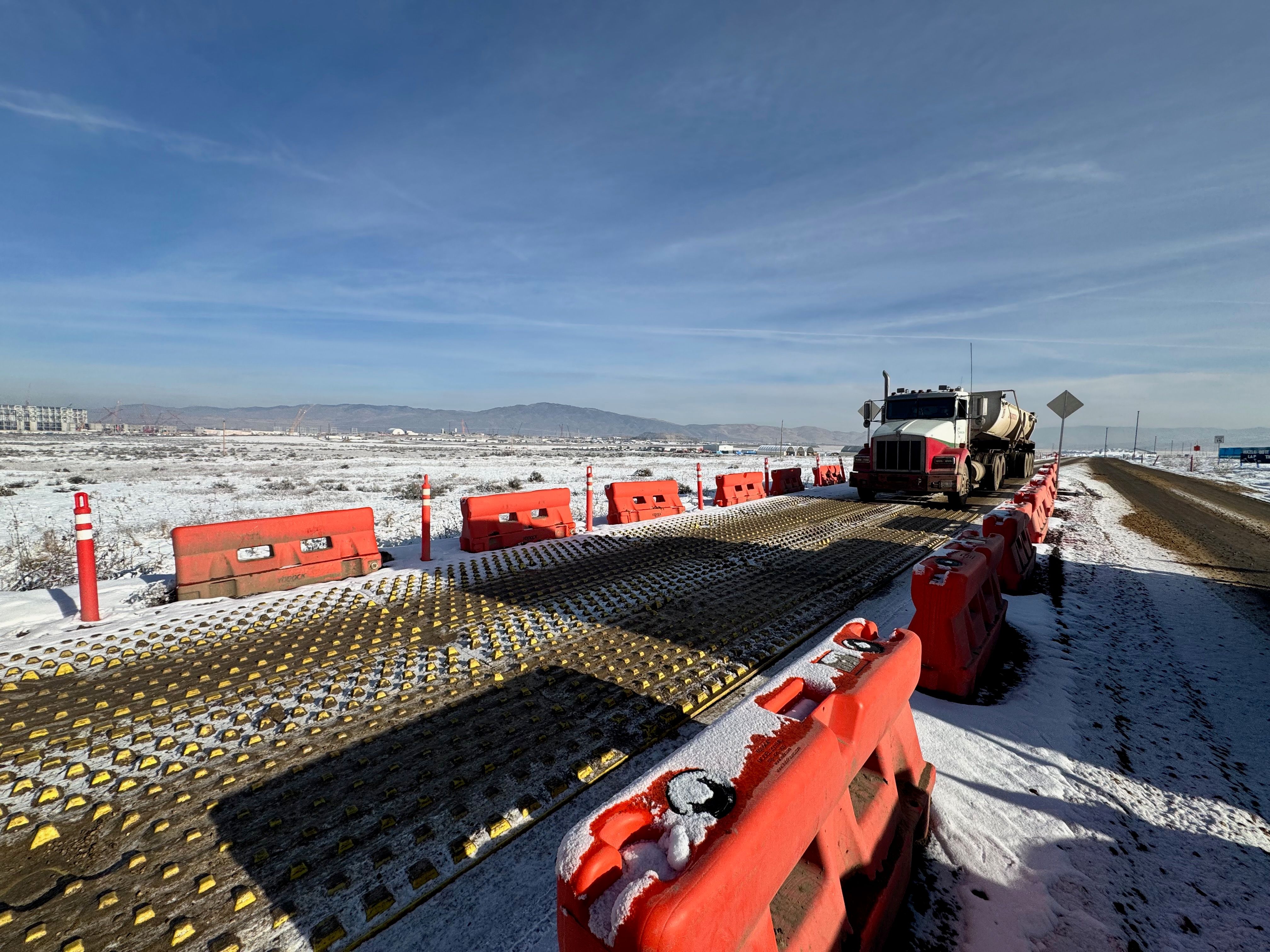Idaho Vehicle Sediment Control BMPs
Idaho is home to many beautiful natural landscapes and boasts some of the most rugged and untouched land in the nation. This wonderful land is percolated with streams of fresh mountain water and larger rivers including the Snake River, Salmon River, Clearwater River and the Boise River. The Snake River flows from Yellowstone National Park and runs through Idaho on its course to join the Columbia River in Washington State. Local and Federal regulations are in place to protect the surface waters throughout the state.
Idaho Department of Environmental Quality (DEQ) NPDES Stormwater Permits
The 1972 revisions to the Clean Water Act established the National Pollution Discharge Elimination (NPDES) Permit Program. Among other things, program ensures that all industrial and construction site operators have proper erosion and sedimentation controls in place to prevent excessive sedimentation which is the most common source of water pollution. The Idaho Department of Environmental Quality (DEQ) administers Program under the Idaho Pollution Discharge Elimination System (IPDES). All program requires all construction activity which disturbs an area of one or more acres of land is required to obtain stormwater permit coverage.
Many construction projects in Idaho can obtain permit coverage under the Construction General Permit (IPDES). To apply for coverage, contractors will submit a Notice of Intent (NOI) and create a Stormwater Pollution Prevention Plan (SWPPP) which outlines both the sources of contaminants on the job site and measures which will be taken to reduce to minimize the effect of these sources on surface waters. Each measure in the SWPPP is called a Best Management Practice, or BMP, which can be either structural or procedural. The DEQ complies the Idaho Catalog of Storm Water Best Management Practices which includes detailed descriptions of BMPs including design considerations, applicability, and maintenance guidelines.
BMP 40: Vehicle Sediment Control BMP
One BMP which is required on all construction sites is Vehicle Sediment Control. The Vehicle Sediment Control BMP is designed to minimize sediment that is deposited on roadways which is tracked out from construction vehicles at egress points. An effective stabilization technique is important because any sediment that is tracked off-site is difficult to remove and easily flows into storm drains. To reduce off-site tracking, entrance points are stabilized with a structure which will clean vehicle tires using a rough surface to remove sediment or a water based solution to clean tires.
To ensure that this BMP effectively contains tracking throughout the site, all construction traffic must be diverted through a stabilized entrance. An effective construction entrance may use a combination of techniques and processes to maximize sediment capture. The SWPPP will include additional BMP processes to capture residual sediment including regular inspections and maintenance, ongoing street sweeping to capture residual track-out, proper grading of the entrance to reduce runoff, and installation of a sediment basin to capture any drainage from the entrance area.
If possible, the Vehicle Sediment Control structure should be graded to enable drainage to flow back into the site to reduce runoff during rain events.
Aggregate Pad Construction Entrance
An Aggregate Pad Construction Entrance is a traditional construction entrance technique which uses aggregate to create a rough surface which can dislodge and contain sediment from vehicle tires. The aggregate pad should use 2- to 8-inch diameter crushed stone and a top layer of 2 inch diameter or smaller stone. A depth of 9 inches is the minimum depth, but additional aggregate can be installed depending on soil type. The pad should be a minimum of 50’ in length, but a 100’ length is often used for increased performance. The the pad should be at least 15’ wide and extended to the full width of the entrance. On high volume sites, the width should be increased to allow two vehicles to exit over the aggregate. The entrance points are flared to provide a wide turn as vehicles turn onto the roadway.
The aggregate is installed over a nonwoven geotextile filter fabric which prevents fine sediment from the substrate from entering the aggregate layer. The filter fabric should be resistant to rot and mildew to prevent breaking down.
The entrance should be inspected regularly and repaired when the majority of sediment is no longer contained. When the aggregate becomes compacted or saturated with sediment, the performance is significantly reduced. Maintenance of an aggregate pad requires installation of additional aggregate (2 inches or more) to top dress the pad and recreate the rough surface. Maintenance frequency will increase during wet seasons as the aggregate can become quickly saturated with mud. Inspections should be conducted after each rain event.
At the end of construction, all aggregate and the geotextile filter fabric must be excavated and removed. Prior stabilization will include restoration of the original soil and may require reseeding with grass and other native plants.
Construction Mat or Turf Reinforcement Mat BMP
Low volume and smaller construction sites may be able to use a Construction Matting or Turf Reinforcement Matting to serve the function of a construction entrance. This type of entrance is designed to reduce rutting and stabilize the entrance, but do not remove significant sediment from vehicle tires. These are often used on soft substrates and saturated soils or wetlands because they can immediately stabilize the substrate and offer some protection to existing vegetation.
When using Turf Reinforcement Mats, woven, or construction mats, a 50’ length of matting and the area should include a wide turn radius. The width of the entrance should be 20’ wide or more to accommodate the largest vehicles which will be using the exit. The entire width of the egress point should be stabilized, or alternatively, vehicles can be restricted to exit over the mats.
Mats can be cleaned as needed to remove sediment that is built up.
Rumble Strips and Rattle Plates BMP
Rumble Strips and rattle plates are steel panels which have corrugated ridges or welded pipe or angled steel which produces rough surface which shakes vehicle axles as they drive over. The shaking motion can help dislodge additional sediment. Some types of rumble strips are raised to provide a void below while others are laid flat on the substrate. These structures are often constructed on-site, but many manufactured options exist. Dimensions vary, but an individual panel is often 10’ wide and 8’ long.
Rumble Strips are often used in combination with aggregate construction entrances to remove additional sediment, and are placed in the center of the aggregate pad. Sediment builds between the ridges and must be swept, scraped or washed to restore functionality.
Wheel Washing Station BMP
If other methods are not effetely cleaning sediment, a wheel washing station may be used. Wash Stations or wash racks are an effective BMP which cleans vehicle tires with pressurized water. Wheel washing stations typically consist of a reinforced concrete rack or cattle guard style structure and a pressurized water source. A wash wash can use a simple, manually operated sprayer or use a more advanced automated sprayer system.
When introducing water to the construction site entrance, proper drainage is required. All runoff should be diverted into a sediment trap to contain sediment on-site.
FODS Trackout Control System
The FODS Trackout Control System is an effective, reusable BMP designed to minimize sediment track out. Compared to traditional aggregate entrances has been shown to reduce street sweeping by 59% in high traffic volume applications. Because the system is highly effective, FODS are commonly specified at 35’ in length to provide equal performance of a 70’ aggregate style construction entrance. The system is designed to be reused and relocated and can provide cost savings on linear projects and over the systems 10+ year lifespan.
The FODS Trackout Control System consists of set of 12’ x 7’ HDPE mats which are formed into pyramid shaped structures on the surface. The pyramids deform and flex vehicle tires in multiple directions to dislodge sediment, rocks, and debris which is lodged between tire treads. The system can be installed over existing substrates including dirt, concrete and asphalt. Installation, maintenance, and removal can be completed without heavy equipment and a standard installation can be completed in under 30 minutes.
The pyramids can hold up to 2.5” of sediment as the tires only come into contact with the tips of the pyramids. When sediment builds between the pyramids maintenance is required. Maintenance of a FODS construction entrance is typically completed using a street sweeper or a skid steer with broom attachment can be used to brush away sediment to restore performance. Cleaning can also be completed manually using a FODS Shovel which is designed to fit between rows of pyramids. Contractors can integrate maintenance during regular street sweeping to ensure the entrance is always compliant with permit requirements.
Additional Resources
Idaho DEQ General Permit for Discharges from Construction Activities

